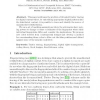Free Online Productivity Tools
i2Speak
i2Symbol
i2OCR
iTex2Img
iWeb2Print
iWeb2Shot
i2Type
iPdf2Split
iPdf2Merge
i2Bopomofo
i2Arabic
i2Style
i2Image
i2PDF
iLatex2Rtf
Sci2ools
AAECC
2006
Springer
2006
Springer
Traitor Tracing Against Powerful Attacks Using Combinatorial Designs
This paper addresses the problem of threshold traitor tracing for digital content where, by embedding appropriate digital patterns into the distributed content, it is possible to trace and identify the source of unauthorised redistribution. We use a set of marking assumptions where the adversaries have varying powers to change or erase coordinates of the fingerprint where their individual fingerprints differ–and consider the implications. We propose new codes derived from combinatorial designs–and develop a method for concatenating these codes to filter out the false positives and defend against some of the attacks considered.
AAECC 2006 | Algorithms | Appropriate Digital Patterns | Threshold Traitor | Unauthorised Redistribution |
| Added | 13 Jun 2010 |
| Updated | 13 Jun 2010 |
| Type | Conference |
| Year | 2006 |
| Where | AAECC |
| Authors | Simon McNicol, Serdar Boztas, Asha Rao |
Comments (0)

